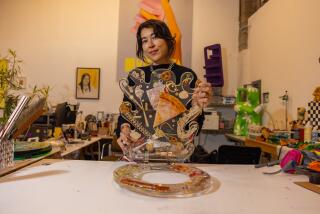Turning Broken Dishes Into Wholly Unique Furnishings
- Share via
If life hands you some lemons, then make lemonade, goes the adage.
But what can you do with a pile of broken dishes? Decorate furniture, of course.
Cheryl Hazan and Cecile Arnaud create fascinating furniture and home accessories by covering the tops, fronts and sides of existing tables, chests, chairs, mirror frames, flowerpots and more with broken crockery.
It takes a lot of broken dishes to cover a piece of furniture--from 18 or so for a small mirror to as many as 500 for a large chest of drawers.
Hazan and Arnaud are fussy about china patterns, artfully selecting those that go well together. They may add three-dimensional elements, too, such as a knob off a sugar bowl or a china rose or tiny figurine.
Sometimes they cut vases in half and glue them onto a vertical surface to hold dried flowers. Two handles off matching cups might be turned into a heart and filled in with pieces in different patterns.
The technique is actually a form of mosaic and has been known for centuries, Arnaud said. One of the most famous examples of mosaics made from broken dishes is in Chartres, France. From the 1930s to the 1940s, a laborer named Raymond Isidore completely covered the interior and exterior of his home and all its furnishings with broken crockery, shells and other discards.
He also created a garden with walls, pavement, flowerpots and grottoes fashioned of the same materials.
At first regarded as a madman, Isidore was christened “Monsieur Picassiette” by his neighbors. The term, translated as plate stealer, was also a mocking reference to Isidore as the Picasso of plates.
The city of Chartres acquired the house in 1981 and opened it as a museum in 1983. It is considered a prime example of so-called outsider art in France.
Hazan, a self-taught designer and craftswoman from Brooklyn, and Arnaud, a self-taught artist and native of Paris, visited the Picassiette house about four years ago. The two, friends and associates in another business, returned to New York and began experimenting in the technique.
In 1996, Hazan opened Anandamali in Manhattan’s TriBeCa section, specializing in the picassiette furniture and accessories. The shop’s unusual name means “blissful garland” in Sanskrit. Prices range from $350 to $6,000 for individual pieces.
Besides selling one-of-a-kind pieces, Anandamali markets a line of somewhat standardized picassiette tables to stores around the country. Custom assignments, such as a kitchen backsplash currently under construction, are also accepted. Occasionally, clients arrive with their own broken plates.
Naturally, creating the pieces requires an unending stock of dishes, both whole and broken.
“We have 10,000 dishes, 98% patterned, as well as bins of broken crockery sorted by color,” Hazan said. “I have scouts all over the eastern seaboard looking for plates at flea markets, yard sales, estate sales, and auctions. When they have 1,000 plates, I get in my truck and go to pick them up.”
Tile nippers are used to cut the rim and bottom ridge off plates, which must be broken if they’ve survived the cutting process. The shards are reassembled into attractive patterns and then glued onto a wood base with a little separation between each piece of china. After the adhesive has dried the piece is grouted like tiles.
Hazan began holding four-session courses this spring at Anandamali. Sara Levine of Belle Harbor, Queens, arrived at the workroom one afternoon to pick up the small tabletop she had made in one of the first classes.
“I am hooked,” she said. “I’ve purchased my own tile snips and have gotten to know all the places where I can buy old china.”
She has five projects in hand, including covering a fireplace and a dining table.
For those who might like to try the craft, Hazan offered safety guidelines. “Wear goggles when cutting, and rubber, vinyl or latex gloves when grouting. The dangers of the craft are eye injuries from china shards, getting cut and getting grout on your skin.”
Anandamali, 35 N. Moore St., New York City, (212) 343-8964.


